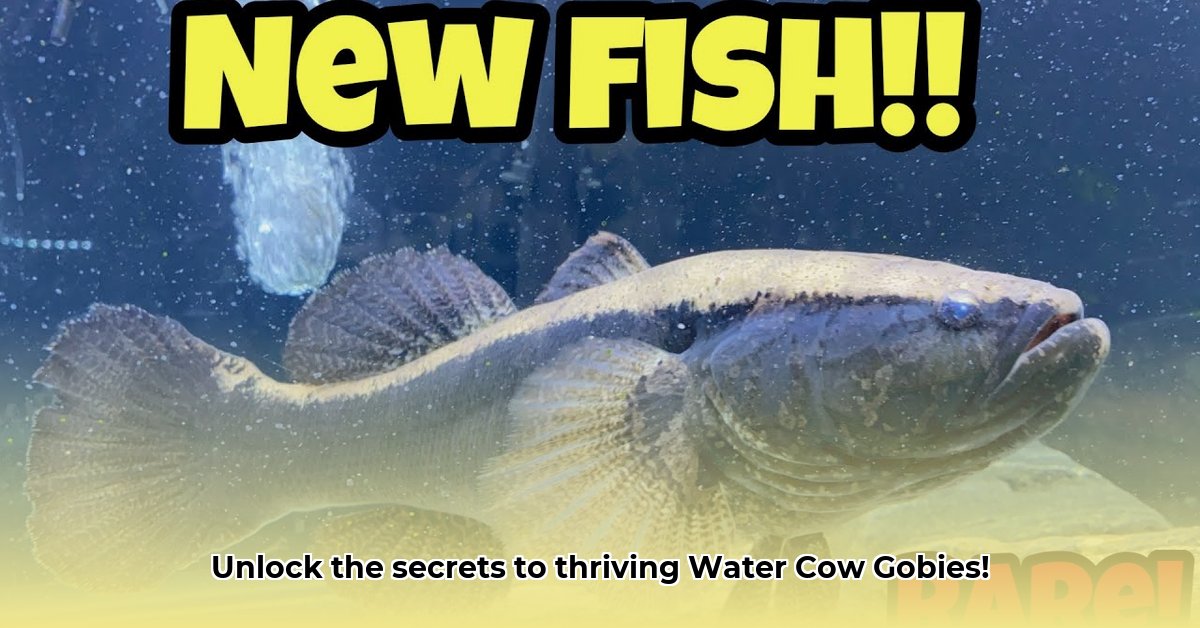
Mastering the art of Water Cow Goby (Amblyeleotris aurora) fishkeeping requires dedication and a keen understanding of their specific needs. This comprehensive guide provides a structured approach to ensuring a thriving environment for these stunning, yet demanding, aquatic creatures. From tank setup to dietary requirements, we’ll cover everything you need to know to successfully maintain your Water Cow Gobies. For more information, check out this helpful resource: Water Cow Info.
Choosing Your Water Cow Goby: Selecting a Healthy Specimen
Before embarking on your Water Cow Goby journey, selecting a healthy fish is paramount. Visit a reputable local fish store or a trusted online vendor. A vibrant, active goby is your target. Look for energetic swimming, a bright coloration, and an absence of any visible signs of disease or lethargy. Don't hesitate to ask questions; a knowledgeable seller is an invaluable resource. Remember, a healthy start significantly increases your chances of long-term success. Isn't a healthy start crucial to their well-being?
Setting Up Their Luxurious Home: Tank Requirements
Water Cow Gobies demand spacious accommodations. A minimum of a 100-gallon tank is essential for a single individual—larger is always better. These fish can grow up to 24 inches! A cramped environment will stress your goby, leading to health issues. A secure-fitting lid is a must to prevent daring escapes. This isn't just about aesthetics, it's about creating a home that replicates their natural environment.
Your tank should be well-established, meaning it has been running for several weeks, allowing beneficial bacteria to colonize and process waste. A powerful filtration system is crucial for managing the waste produced by these larger fish. Regular water changes (approximately 25% weekly) maintain water quality. A deep sand bed allows burrowing, enhancing their sense of security. Include live rock for hiding places, mirroring their natural habitat.
Water Conditions: Maintaining the Ideal Environment
Maintaining optimal water parameters is crucial for your goby's health. Regular testing is key! Aim for the following:
| Parameter | Ideal Range | Notes |
|---|---|---|
| Temperature | 72-82°F (22-28°C) | Consistent temperature is vital. Avoid sudden fluctuations. |
| Salinity | 1.005 to 1.015 | This can vary slightly, consult your supplier for their specific needs. |
| pH | 7.8 - 8.5 | Slightly alkaline water is preferred. |
| Ammonia | 0 ppm | Zero ammonia is absolutely essential for their survival. Test regularly! |
| Nitrite | 0 ppm | Zero nitrite is just as important as zero ammonia. |
| Nitrate | <20 ppm | Keep nitrates low through consistent water changes. |
Even small deviations from these ranges can negatively impact your goby's health. Consistent monitoring and prompt adjustments are essential.
Feeding Your Water Cow Goby: A Carnivorous Diet
Water Cow Gobies are carnivores, requiring a diet rich in high-quality protein. Offer a variety of live or frozen foods, including mysis shrimp, brine shrimp, and appropriately sized small fish. Varying the diet is essential for optimum nutrition. Never overfeed! Small portions twice daily are sufficient. Remove any uneaten food promptly to prevent water quality issues. What's the best way to ensure your goby receives adequate nutrition? A varied, high-protein diet!
Potential Challenges and Solutions
Even with diligent care, challenges can arise. Prepare yourself:
- Aggression: While generally peaceful, Water Cow Gobies can exhibit aggression towards tank mates, particularly smaller fish. A species-only tank is often the best approach.
- Disease: Maintaining pristine water quality and quarantining any new additions to the tank are crucial preventative measures.
- Misidentification: Verify the species before purchase; look-alikes exist.
Breeding Water Cow Gobies: A Complex Endeavor
Breeding Water Cow Gobies in captivity is exceptionally challenging, and success rates remain low. This usually requires detailed experience and specialized knowledge. It requires a dedicated, larger-than-usual breeding tank, maintaining pristine water conditions, and a precise diet.
Key Considerations for Breeding:
- Tank Size: A minimum 100-gallon tank, even larger for multiple fish.
- Water Quality: Impeccable water parameters are critical. Regular testing and water changes are non-negotiable.
- Diet: High-protein, varied diet.
- Social Dynamics: Aggression between males can hinder breeding; carefully manage tank inhabitants.
Currently, detailed research on captive breeding is limited, emphasizing the need for diligent observation and continuous refinement of techniques.
Conclusion: Embark on Your Water Cow Goby Journey
Keeping Water Cow Gobies is a rewarding yet demanding pursuit. This guide serves as a foundation, but success hinges on attentiveness, adaptation, and an unwavering commitment to maintaining their well-being. Remember, consistent monitoring and proactive adjustments are key to creating a thriving environment for these fascinating fish. Are you ready to meet the challenges and enjoy the rewards of caring for a Water Cow Goby?